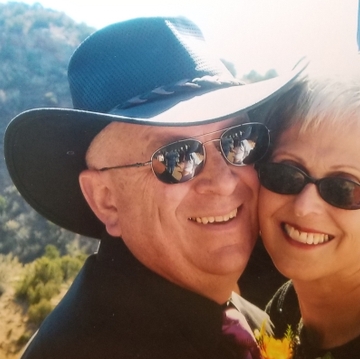New Mexico Approves Master of Science in Anesthesia Program at UNM

Pushups to Push Through
A New Mexico Patient's Battle With COVID-19 Sparks a Worldwide Exercise Movement
UPDATE: Harold Rushton passed away on the morning of Saturday, May 2. Our heartfelt condolences go out to his family, who were grateful for the dedicated care he received at UNM Sandoval Regional Medical Center
---
Even in his 70s, Harold Rushton was in such robust health that he would do 50 pushups every day - and often challenge his kids, nieces, nephews and grandkids to follow suit.
So it was a shock to his entire family when the longtime Rio Rancho resident was admitted to UNM Sandoval Regional Medical Center on the evening of March 29, where he tested positive for the COVID-19 infection.
Rushton was struggling to breathe, and X-rays showed he had double pneumonia. He was promptly admitted to the intensive care unit as the hospital's first COVID-positive patient.
The next morning he called Jill, his wife of 51 years.
"He said, 'This is pretty scary,'" she says. "He had to stop and take a breath between those words." Just then, doctors came in to connect him to a ventilator. "That was the last time that I talked to him - that he talked to me, anyway."
He would go on to spend nearly a month in a medically induced coma, intubated and on a ventilator in the ICU. Jill describes it as "a rollercoaster ride," but credits the support she has received from the couple's six children, her husband's siblings and their large extended family.
Remembering Rushton's fondness for pushup competitions, nephew Lee Rushton suggested during a nightly joint Zoom meeting that family members "do pushups to push through." That idea led to Push-Ups To Push Through, a challenge to do pushups to support those dealing with COVID-19. The pushup challenge has become a global phenomenon, says son Jeff.
"We've had people all over the world doing it," he says. "We have videos of people in Africa. We have videos of lizards doing it. We have people in Italy during their crisis who were cheering for my dad. People all over the world are either doing pushups or cheering for him to get healthy."
Earlier this week his family received some good news. Rushton underwent a tracheostomy - a hole in his throat that now connects to the ventilator - and his condition had improved to the point where he could be transferred to a long-term acute care center.
"It was a huge step forward," says Lance Larson, MD, assistant professor in the UNM Division of General Surgery, who helped oversee Rushton's care. "He's tried to die two or three times, and he's pulled through. He's a really strong person."
Larson praises the ICU nursing staff and respiratory therapists for the care they provided.
"We've been at his bedside endlessly for 30 days trying to help him get better," says Elizabeth Stauss, RN, the ICU nursing manager. "We had several patients here that were ruled out for having coronavirus. So it became real to us when we had him as our first patient. There was a lot of anxiety. It was really stressful, but it's getting better."
Her colleague LoraAnn Lovato, RN, remembers that when Rushton was admitted, "He was so selfless and was more worried about the nursing staff and our safety and us getting home and getting rest. I think that just speaks volumes about the kind of person he is, and we're honored to care for him."
Members of the ICU team even got down outside Rushton's room and squeezed out pushups for a video they shared with the family. "You could see all of these nurses and respiratory therapists out there doing pushups helping Dad to push through," Jeff says.
The family members are effusive in their praise for the efforts of the SRMC ICU team.
"He's been in an excellent hospital," says Jill Rushton, who also tested positive for the virus and has since recovered. "We're so grateful for the doctors and nurses who've gone way above and beyond . . . They're doing everything they can for him, and they've been so accommodating to us."
Her husband has already beaten the odds for COVID patients on ventilators, only 14 percent of whom survive, she says. "My husband was on a ventilator one day short of four weeks. That's two weeks longer than is safe, but he's still alive."